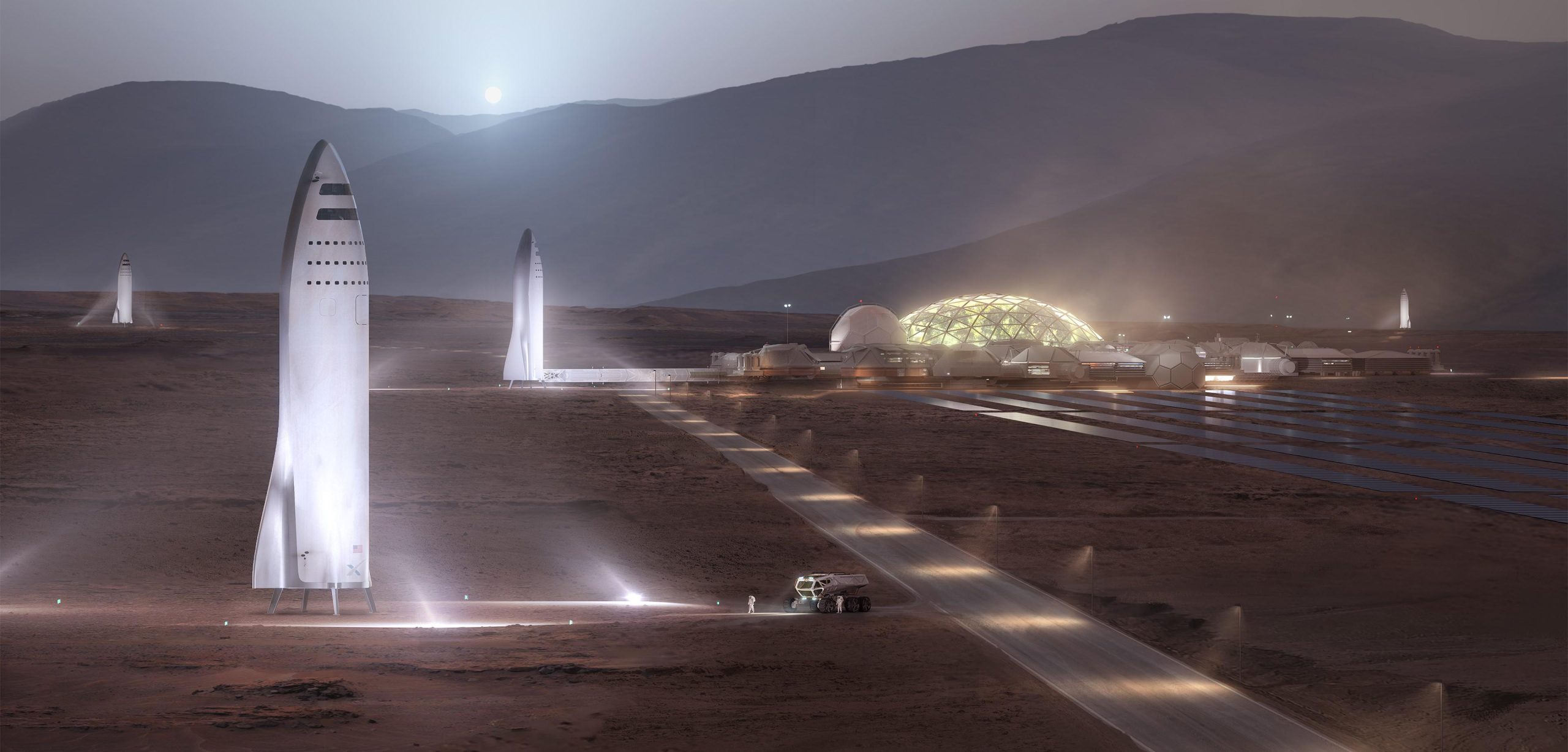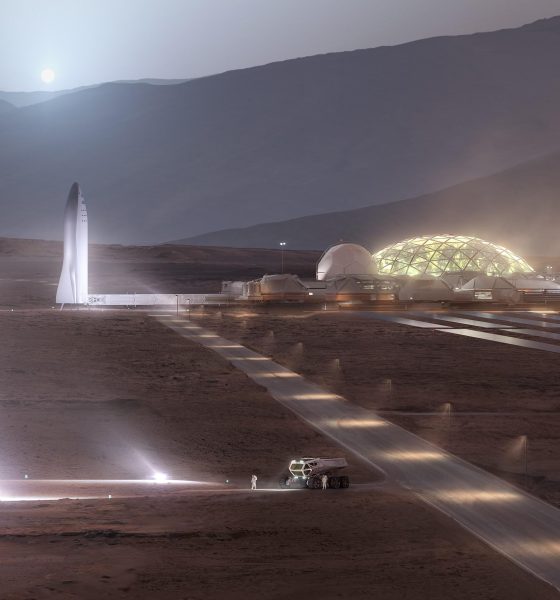

News
SpaceX wants to use the first Mars-bound BFR spaceships as Martian habitats
Speaking at the 2018 Mars Society Convention, SpaceX’s Principal Mars Development Engineer Paul Wooster briefly presented on the company’s BFR and Mars colony ambitions.
While the majority of the 30-minute talk rehashed CEO Elon Musk’s 2017 BFR update and subsequent Reddit AMA, it also happened to contain a handful of new details and slides, including a suggestion that the first BFR spaceships to land on Mars will stay on the Red Planet as temporary habitats or tools for early colonists.
SpaceX Mars architecture features pic.twitter.com/IHOLCbbvRS
— Maxime Lenormand (@MaxLenormand) August 25, 2018
The senior engineer reiterated the company’s aspirational Martian launch targets, featuring two uncrewed cargo BFRs in 2022 and four total BFRs in 2024, two crewed and two uncrewed. Whether or not the lack of change in those dates (provided by Wooster nearly a year after CEO Elon Musk’s identical date reveal in September 2017) asserts that SpaceX’s BFR and Mars research and development remains on track, it almost certainly confirms that the company’s incredibly aggressive targets are here to stay.
Graciously documented by Reddit users /u/theinternetftw and /u/Nehkara and European Space Agency intern Maxime Lenormand, at least partially alleviating the unbelievably atrocious webcast quality, Wooster offered attendees a slightly deeper glimpse into the extensive in-depth planning going on behind the scenes at SpaceX. Almost all of the new slides Wooster presented focused heavily on the technical side of actually planning to create a self-sustaining Martian colony, ranging from locations for any prospective colony to the types of skillsets that would be exceptionally invaluable in early colonists.
And here are some additional considerations pic.twitter.com/jdVJglfHCG
— Maxime Lenormand (@MaxLenormand) August 25, 2018
At this point, it’s entirely possible that SpaceX’s internal team of Mars-focused engineers and experts has already begun to approach or even surpass the detail and value of previous theoretical Martian colonization research from the likes of NASA, ESA, and other space agencies and companies. Still, SpaceX has made it eminently clear that it wants and likely needs to collaborate with independent experts on Mars, life support systems, construction, resource extraction and refinement, and more.
A private Mars workshop recently hosted by SpaceX – likely the first of many to come – evidenced that desire to collaborate with companies, agencies, and researchers that have already put years of effort into analyzing and answering the same questions SpaceX will need to answer to successfully build a sustainable city on Mars
- A Crew BFS (Big F____ Spaceship) pictured landing on Mars. (SpaceX)
- SpaceX’s Big F____ Spaceship (BFS) pictured near a conceptual Mars base, including a domed common area. (SpaceX)
Perhaps the most interesting detail to come out of Wooster’s August 25th talk, however, was the slight affirmation that SpaceX is seriously thinking about leaving the first landed BFR spaceships on Mars indefinitely, although it’s not entirely clear which spaceships he was referring to. According to paraphrased notes taken from the webcast, early BFR spaceships on the Martian surface would remain there to be used as resources (habitats). He subsequently noted that early colonists would “probably” live out of the first landed spaceships, to begin with, suggesting that the uncrewed, cargo-dedicated spaceships would still return to Earth, as they will not feature human-rated life support systems of any of the necessities for living.
Still, multiple other slides in Wooster’s presentation make it clear that the goal from the very beginning of the first BFRs to Mars is to expand living space and infrastructure as quickly as possible, paving the way for the arrival of more and more colonists. It’s extremely likely that a significant number of skilled colonists will be needed to ensure that the colony remains healthy and safe, while also guaranteeing that it can sustainably grow as rapidly as feasible.
Plans are for sending the first 2 cargos as soon as 2022! pic.twitter.com/A5y3HNpIOx
— Maxime Lenormand (@MaxLenormand) August 25, 2018
Even though it certainly wasn’t the “BFR update” Musk suggested was coming soon, Wooster’s presentation provided the best glimpse yet into the extensive analysis and planning SpaceX is undertaking to discern how exactly to best structure its very first colony-focused launches to Mars.
For prompt updates, on-the-ground perspectives, and unique glimpses of SpaceX’s rocket recovery fleet check out our brand new LaunchPad and LandingZone newsletters!

News
Tesla Model Y Standard Long Range RWD launches in Europe
The update was announced by Tesla Europe & Middle East in a post on its official social media account on X.

Tesla has expanded the Model Y lineup in Europe with the introduction of the Standard Long Range RWD variant, which offers an impressive 657 km of WLTP range.
The update was announced by Tesla Europe & Middle East in a post on its official social media account on X.
Model Y Standard Long Range RWD Details
Tesla Europe & Middle East highlighted some of the Model Y Standard Long Range RWD’s most notable specs, from its 657 km of WLTP range to its 2,118 liters of cargo volume. More importantly, Tesla also noted that the newly released variant only consumes 12.7 kWh per 100 km, making it the most efficient Model Y to date.
The Model Y Standard provides a lower entry point for consumers who wish to enter the Tesla ecosystem at the lowest possible price. While the Model 3 Standard is still more affordable, some consumers might prefer the Model Y Standard due to its larger size and crossover form factor. The fact that the Model Y Standard is equipped with Tesla’s AI4 computer also makes it ready for FSD’s eventual rollout to the region.
Top Gear’s Model Y Standard review
Top Gear‘s recent review of the Tesla Model Y Standard highlighted some of the vehicle’s most notable features, such as its impressive real-world range, stellar infotainment system, and spacious interior. As per the publication, the Model Y Standard still retains a lot of what makes Tesla’s vehicles well-rounded, even if it’s been equipped with a simplified interior.
Top Gear compared the Model Y Standard to its rivals in the same segment. “The introduction of the Standard trim brings the Model Y in line with the entry price of most of its closest competition. In fact, it’s actually cheaper than a Peugeot e-3008 and costs £5k less than an entry-level Audi Q4 e-tron. It also makes the Ford Mustang Mach-E look a little short with its higher entry price and worse range,” the publication wrote.
Elon Musk
Elon Musk’s xAI bets $20B on Mississippi with 2GW AI data center project
The project is expected to create hundreds of permanent jobs, dramatically expand xAI’s computing capacity, and further cement the Mid-South as a growing hub for AI infrastructure.

Elon Musk’s xAI plans to pour more than $20 billion into a massive new data center campus in Southaven, Mississippi, marking the largest single economic development project in the state’s history.
The project is expected to create hundreds of permanent jobs, dramatically expand xAI’s computing capacity, and further cement the Mid-South as a growing hub for AI infrastructure.
xAI goes MACROHARDRR in Mississippi
xAI has acquired and is retrofitting an existing facility in Southaven to serve as a new data center, which will be known as “MACROHARDRR.” The site sits near a recently acquired power plant and close to one of xAI’s existing data centers in Tennessee, creating a regional cluster designed to support large-scale AI training and inference.
Once completed, the Southaven facility is expected to push the company’s total computing capacity to nearly 2 GW, placing it among the most powerful AI compute installations globally. The data center is scheduled to begin operations in February 2026.
Gov. Tate Reeves shared his optimism about the project in a press release. “This record-shattering $20 billion investment is an amazing start to what is sure to be another incredible year for economic development in Mississippi. Today, Elon Musk is bringing xAI to DeSoto County, a project that will transform the region and bring amazing opportunities to its residents for generations. This is the largest economic development project in Mississippi’s history,” he said.
xAI’s broader AI ambitions
To secure the investment, the Mississippi Development Authority approved xAI for its Data Center Incentive program, which provides sales and use tax exemptions on eligible computing hardware and software. The City of Southaven and DeSoto County are also supporting the project through fee-in-lieu agreements aimed at accelerating development timelines and reducing upfront costs.
Founded in 2023 by Elon Musk, xAI develops advanced artificial intelligence systems focused on large-scale reasoning and generative applications. Its flagship product, Grok, is integrated with the social media platform X, alongside a growing suite of APIs for image generation, voice, and autonomous agents, including offerings tailored for government use.
Elon Musk highlighted xAi’s growth and momentum in a comment about the matter. “xAI is scaling at an immeasurable pace — we are building our third massive data center in the greater Memphis area. MACROHARDRR pushes our Colossus training compute to ~2GW – by far the most powerful AI system on Earth. This is insane execution speed by xAI and the state of Mississippi. We are grateful to Governor Reeves for his support of building xAI at warp speed,” Musk said.
Elon Musk
Tesla AI Head says future FSD feature has already partially shipped

Tesla’s Head of AI, Ashok Elluswamy, says that something that was expected with version 14.3 of the company’s Full Self-Driving platform has already partially shipped with the current build of version 14.2.
Tesla and CEO Elon Musk have teased on several occasions that reasoning will be a big piece of future Full Self-Driving builds, helping bring forth the “sentient” narrative that the company has pushed for these more advanced FSD versions.
Back in October on the Q3 Earnings Call, Musk said:
“With reasoning, it’s literally going to think about which parking spot to pick. It’ll drop you off at the entrance of the store, then go find a parking spot. It’s going to spot empty spots much better than a human. It’s going to use reasoning to solve things.”
Musk said in the same month:
“By v14.3, your car will feel like it is sentient.”
Amazingly, Tesla Full Self-Driving v14.2.2.2, which is the most recent iteration released, is very close to this sentient feeling. However, there are more things that need to be improved, and logic appears to be in the future plans to help with decision-making in general, alongside other refinements and features.
On Thursday evening, Elluswamy revealed that some of the reasoning features have already been rolled out, confirming that it has been added to navigation route changes during construction, as well as with parking options.
He added that “more and more reasoning will ship in Q1.”
🚨 Tesla’s Ashok Elluswamy reveals Nav decisions when encountering construction and parking options contain “some elements of reasoning”
More uses of reasoning will be shipped later this quarter, a big tidbit of info as we wait v14.3 https://t.co/jty8llgsKM
— TESLARATI (@Teslarati) January 9, 2026
Interestingly, parking improvements were hinted at being added in the initial rollout of v14.2 several months ago. These had not rolled out to vehicles quite yet, as they were listed under the future improvements portion of the release notes, but it appears things have already started to make their way to cars in a limited fashion.
Tesla Full Self-Driving v14.2 – Full Review, the Good and the Bad
As reasoning is more involved in more of the Full Self-Driving suite, it is likely we will see cars make better decisions in terms of routing and navigation, which is a big complaint of many owners (including me).
Additionally, the operation as a whole should be smoother and more comfortable to owners, which is hard to believe considering how good it is already. Nevertheless, there are absolutely improvements that need to be made before Tesla can introduce completely unsupervised FSD.










